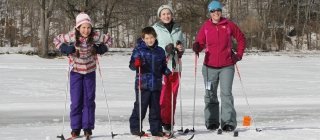Preventing Winter Injuries

Don't let the cold weather or slippery sidewalks keep you indoors—learn how to protect yourself while enjoying the snowy season.
Slipping and falling on ice, shoveling heavy snow, and exposing skin to frigid temperatures are some of the ways we can hurt ourselves during the colder months. Injuries can also happen while we’re enjoying outdoor winter activities like skiing, snowboarding, and sledding.
Vermont’s long winters don’t have to be hazardous to your health. You can work and play in the snowy weather safely, if you take a few simple steps to prevent winter injuries. In this article, we’ll share some of our favorite tips for staying healthy and safe outdoors during the winter.
Staying Warm and Dry
Cold temperatures and gusty winter winds are more than uncomfortable -- they can cause serious injury, if you are unprepared for frostbite and hypothermia.
- Frostbite usually happens when skin is exposed, but it can also affect skin that’s covered. Cold and wind cause numbness in the fingers, toes, ears, nose, and other extremities. Frostbite can happen in only a few minutes on very cold days. As the skin freezes it changes color and there may be permanent damage. Learn more about frostbite.
- Hypothermia happens when the body loses heat faster than it can produce it, dropping from the normal 98.6 degrees Fahrenheit to below 95 degrees. Hypothermia can happen within 30 minutes. As hypothermia sets in, the heart and other organs can’t work properly and begin to fail. The result can be deadly. Learn more about hypothermia.
Protecting yourself against frostbite and hypothermia begins before you step outside. Selecting the right winter clothing will keep you warm and dry, reducing your risk of injury. Start by dressing in layers:
- Base layer has midweight polyester long underwear (both top and bottom) that wicks sweat away from your skin. Avoid cotton as a base layer, as it retains moisture and can make you chilly.
- Middle layer has an insulated jacket and fleece pants to help retain body heat.
- Outer layer has a weatherproof jacket and pants that act as a shell to block wind, snow, and rain.
Not only is dressing in three layers the most effective way to stay warm and dry, it also allows you to remove a layer if you become too hot from strenuous activity. You can better control your body temperature and avoid sweating, which pulls heat away from your body.
Wearing these clothing items will provide additional protection:
- Toque or beanie that hugs your head and covers your ears. Look for one that is insulated or thick enough to keep your head warm.
- Mittens or gloves with insulation. Mittens generally will keep your hands warmer, but gloves are better for dexterity. Having several pairs is ideal, as you can pick one that is best suited for what you are doing. Some are made with waterproof materials like Gore-Tex that will help keep your hands dry.
- Insulated and waterproof winter boots. Look for a pair tall enough to keep the snow and slush out and that have deep tread to provide traction on slippery surfaces.
- Thick wool socks add a layer of insulation for your feet. On very cold days, you may want to double them up.
- Neck gaiter will protect your throat from exposure, and you can pull it up over your chin and nose when needed.
- Balaclava mask will cover your neck, nose and face, and ears. You can wear one of these under your winter hat.
When you are dressed properly for the winter weather conditions, you’ll be more comfortable when participating in your favorite winter sports and be better prepared to take on outdoor tasks like shoveling snow.
Snow Removal Tips
Snow removal is one of the most difficult -- but important -- jobs during the winter season. Snow with high water content is very heavy and shoveling it puts stress on your heart. It’s called “heart attack snow” for good reason. Shoveling snow improperly can also strain your back, shoulders, and other joints.
To prevent injuries from shoveling snow, follow these tips:
- Shovel during a storm to keep it from piling up. It’s much easier to shovel three inches of snow a couple of times during a storm than to shovel six inches after the storm is over.
- Warm up your muscles first by doing some stretching inside before you begin shoveling. Stretch the muscles you’ll use when shoveling snow, including your arms, shoulders, legs, and back. Don’t forget to stretch after you finish, as well.
- Push the snow to the snowbank, rather than trying to lift and throw it. Using a scoop that you push along the ground to move snow can be very helpful in this regard.
- If you do have to lift the snow, lift with your legs, not your back. Don’t twist your body.
- Take frequent breaks and stop immediately if you feel short of breath or have any chest pain.
- If shoveling snow is difficult for you, consider letting machinery like a snowblower do the work, ask a neighbor to help, or hire a professional snow removal service.
How to Avoid Falls
Falls are one of the most common wintertime injuries, often caused by slipping on driveways, walks, and steps. About one million people in the U.S. are injured each year from falling on ice and snow, according to the Centers for Disease Control and Prevention (CDC).
To help keep you and your family from being injured by a winter tumble, here is some advice:
- Wear winter boots with plenty of tread. Good winter boots are your best defense against slips and falls, as their tread is designed to provide traction on snow and ice. Look for boots that also support your ankles. You can purchase traction devices that slip over the soles to add extra grip. Some of these devices have miniature spikes or studs -- like those on studded winter tires – to help keep your footing on slick surfaces.
- Slow down and shorten your gait. Walking in the winter should be at a slower pace than at other times of the year. Change your stride to take shorter steps and pay closer attention to where you are placing your feet. Shuffling along like a penguin on slippery surfaces will help keep you upright.
- Use handrails on stairs to provide three points of contact (your two feet and one hand) for maximum stability. If there is no handrail, using something like a shovel, walking stick, or cane will provide the third point of contact to increase stability.
- Don’t carry heavy, bulky objects that can cause you to lose your balance. Ask a family member or friend to help you move bigger things across slippery areas.
- Wipe your feet before entering a heated building so that you don’t slip when the snow and ice on your footwear begins to melt. Even when walking on a cold floor, it’s a good idea to get as much snow and ice off your boots as you can.
- Keep steps free of snow and ice. Use rock salt or other chemicals to melt any ice that has accumulated, if necessary.
- Leave a thin layer of snow on driveways and walkways if the conditions are right. A fresh layer of light, dry snow can provide very good traction. On the other hand, if the snow is wet, you should remove it so that it doesn’t pack down and turn into ice later.
- Bring your cellphone so that you can call for help if you fall and can’t get up.
Winter Sports Safety
Sprains, strains, dislocated joints, and fractured bones are some of the most common injuries from winter sports. About 200,000 people in the U.S. are injured every year while participating in winter sports, including skiing, snowboarding, ice hockey and skating, and sledding. To keep yourself from being injured, here are some safety tips:
- Warm up beforehand. Cold muscles, tendons, and ligaments are more susceptible to being injured. Stretching before you get on the ice or snow will help you perform better and make your body less vulnerable to being hurt.
- Stay hydrated. It may not seem like you are sweating while playing winter sports, but your body does lose water even in the winter. Drink plenty of water or a hot beverage like tea to stay hydrated.
- Wear appropriate protective gear. In addition to dressing in layers (see above), you should always wear the correct protective equipment for the sport, including goggles and helmets. Check that the gear is in good working condition before going out.
- Know and follow the rules of the sport you are participating in. If you are a newcomer, take lessons from a qualified instructor. Not all snow is soft, so learning how to fall correctly will help prevent injury from landing on ice or hard-packed snow.
- Stay on the trails. It is very easy to get disoriented in the woods in the winter, so always stay on marked trails to avoid getting lost. Take a map of the area and compass with you. A flashlight or headlamp is another important piece of gear to have, as it gets dark early in the winter.
- Pay attention to weather forecasts if you are going to be outside. Be prepared for the expected temperatures and conditions, and consider staying home in storms. Tell someone where you are going and what time you are planning to return.
- Take a friend with you. It’s much safer to take someone along when participating in a winter activity, so they can help if you are injured.
- Stop when you get tired. People are more likely to be injured when they are exhausted, so if you feel fatigued, it’s best to stop before getting hurt.
- Learn the warning signs of frostbite or hypothermia. The CDC has published online information about what to look for and do. If you or someone in your group shows signs of frostbite or hypothermia, seek shelter and get medical help immediately.
We hope you and your family will get outside often and stay active this winter. Following these tips will help ensure that your winter activities are injury-free. While you are outside having fun and getting fit this winter, please take some photos and share them with us during our annual Snow Days event. Enjoy the snow!



